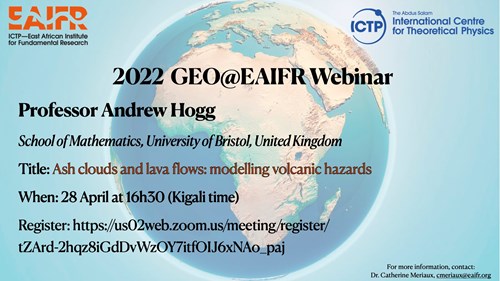ICTP-East African Institute for Fundamental Research
KIST2 Building CST
Nyarugenge Campus
University of Rwanda
Kigali, Rwanda
GEO@EAIFR 2022
Professor Andrew Hogg from Bristol University, UK, will give a GEO@EAIFR webinar discussing modelling volcanic hazards

The East African Institute for Fundamental Research (EAIFR) and the International Centre for Theoretical Physics (ICTP) wish to inform those who may be interested of a GEO@EAIFR webinar. This seminar will take place next week and will be broadcast live on ZOOM. It will also be recorded and later posted on the ICTP-EAIFR YouTube channel, where one can find the previous recorded GEO@EAIFR webinars. Below all the details:
Speaker: Professor Andrew Hogg from the School of Mathematics, University of Bristol, United Kingdom
Title: Ash clouds and lava flows: modelling volcanic hazards
When: 28 April at 16h30 (Kigali time)
Register in advance for this meeting by clicking here.
All are very welcome.
Biography:
Trained as a mathematician at University of Cambridge for both undergraduate and postgraduate studies, completing a thesis under the supervision of Prof. Herbert Huppert. Appointed as a Lecturer in applied mathematics at University of Bristol, and now a Professor of Fluid Mechanics at the same institution.
I have worked on a number of multiphase fluid dynamical problems, motivated by large-scale environmental phenomena. These studies include the dynamics of snow avalanches, sediment transport and debris flows.
Abstract:
Volcanic activity poses many potent hazards to lives and livelihoods and in this seminar I will present some mathematical models of the large-scale, multiphase flows that arise. Particular focus will be given to two distinct problems: the rise through the atmosphere of ash-laden volcanic plumes; and the interaction of volcanic lava flows with topography and obstacles.
In 2010, the eruption Eyjafjallajokull (Iceland) brought air traffic to a standstill for several weeks as the ash-laden plume drifted across northern European airspace. Modellers were ill-equipped to quantify the atmospheric concentrations of ash and direct measurements were unavailable. The research results presented here tackle part of this problem by developing a model for the rise and intrusion of the plume from the vent through the atmosphere to allow the source strength, and thus the concentration of ash to be deduced from measurements of the height of rise and properties of the atmosphere.
The very recent eruption on La Palma (Canary Islands, 2021) has shown that effusive volcanic activity that produces lava flows can be long-lived, damage infrastructure and require evacuations from inundated regions. These relatively slow-moving flows are gravitationally-driven and steered by topography. When they encounter obstacles, they are deflected but form relatively deep, upstream pools of fluid. Quantitative results of models of these flows and interactions will be presented.



